Editing workshop with Nathan – Using Affinity software
Studio bookings, work in progress with partners
WEDNESDAY: Discussion of work in progress and editing time in class
Editing workshop with Nathan – Using Affinity software
Studio bookings, work in progress with partners
WEDNESDAY: Discussion of work in progress and editing time in class
Video Art: One FEAT, Three Ways*
You will work with a partner to make three videos less than 2-minutes each in length each.
Your videos should be shot at the studio in controlled, illuminated conditions.
Pick yourFEAT. You will repeat variations on your “FEAT” in each video below.
Your FEAT should be an everyday gesture or activity that you can push to its limits. Push yourself to your limits. Push a material to its limits. Do not take ANY risks with your safety – subtle, quiet, funny risks are better and more interesting anyway. Just watching someone smiling as long as they can as hard as you can is fascinating and even painful to watch for its duration.
Examples of gestures from past students include: Eating something, Juggling, Kissing, Blowing up a Balloon, Smiling, Holding an Awkward Pose, Reaching for Things out of Reach… etc.
It might be an absurd thing – something pointless, or an impossible feat that you can’t actually do
The object is to try to do the thing, not to “act” – and what happens… happens! You, your partner, or someone else may perform. Maintain your concentration and explore how a simple gesture becomes interesting when performed with commitment and intention.
NOTE: Add titles to each video, and videos should be approximately 1-2 minutes in length.
Video #1: The One-Shot
The video will consist of “one shot” – there will be no editing, other than a black screen to mark the beginning and end of the video. You may focus on camera function, unusual points of view, and framing. You will also add titles and end credits to your videos.
Video #2: The Sequence
The object of this video exercise is to shoot a series of shots with the intention to edit them into a sequence. It may require 5 minutes, an hour, a day, or a week, and you can show it in a series of stills or a time lapse. Edit your footage to be less than two minutes.
Video #3: The Loop
The object of this video exercise is to create a video that is meant to be played over and over again indefinitely, without stopping. Consider the content of the video when you are shooting your feat, and use looping to complete the meaning of the work. Don’t make a short GIF type video – think of a longer loop – something that could play in a gallery without end.
Edit your loop footage to be less than 2 minutes long, and then play on a loop for the critique.
_______________________________________________________________
Videos will be graded by the degree to which students demonstrate understanding of the key concepts in the assignment including the clarity and originality of ideas, investment of time and contributions to the group, consideration of context for the video, technical success using lighting and professional camera equipment in works, technical success using editing software and exporting gallery-quality video, presentation and openness to feedback during critique.
Students are also expected to post a final work (including any revisions after critique) to the class blog with a title, artist names, and a short description of the work within ONE WEEK of the critique for final marks.
Videos will not receive a grade until a work is posted on the class blog.
Video Artist references:
Yoko Ono
Bruce Nauman
Adrian Piper
Pipilotti Rist
Michelle Pearson Clarke
Lee Walton
William Wegman
Jon Sasaki
Camille Turner
Marina Abramovic
Kelly Mark
Euan MacDonald
Wood and Harrison
Erwin Wurm
Maria Hupfield
**Be safe and respectful to yourself and others at all times! Talk with me if you have any questions about your project. Never perform unsafe activities for your projects in this or any class in Studio Art.
Camera Demo
Lighting Demo
Booking studio time
—
Wednesday: Discuss ideas
https://www.nytimes.com/2022/11/21/arts/dance/gesture-archive-art.html
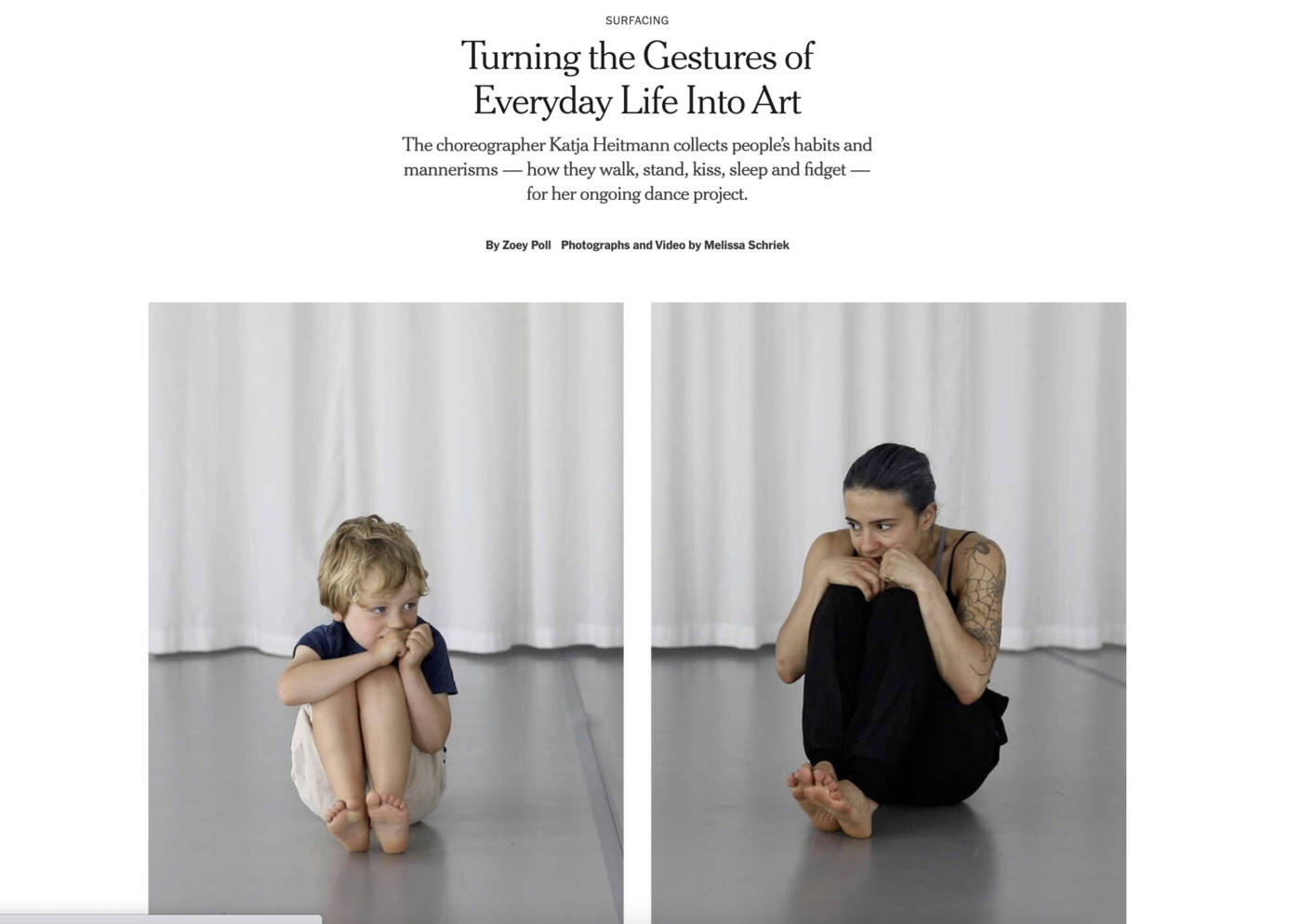
(from Yoga, and dance)
Habits of of movement exchange:
At the end, you should have three, 30-second videos of other students performing an archive of movements. Use this footage for your editing workshop.
See Nathan to book studios and lighting, and for technical and camera assistance.
Talk to Rachelle for bookings in the Photo studio – in 406
If you had to sum up this action in one instructional sentence or formula it would be something like:
Use your hands to feel a diverse range of things in the city.
Notice he takes the common expression “Getting a Feel for Things” literally in this work, and feels things. See how he uses common expressions, and simple instructions as a formula for creating in the following videos.
If conceptually informed artworks are ones in which an idea determines the work, as opposed to the artist’s masterful technique, or the perfect handling of materials. In fact, when you follow directions, things might even turn out badly, things can break down, fail, fall apart. There is tremendous tension in this – when we really don’t know how things are going to go. Watch Jon Sasaki play with attempting to do something, and the possibility (and sometimes the reality) of failing, falling, or otherwise destroying everything.
Sniff:
https://kellymark.com/V_Sniff1Video.html
Hello/Goodbye:
https://kellymark.com/V_HelloGoodbyeVIDEO.html
I love Love Songs but Angry Music Makes me Happy:
https://kellymark.com/V_ILoveLoveSongsVIDEO.html
Ladder Climb:
http://www.jonsasaki.com/index.php/work/ladder-climb/
Dead End, Eastern Market, Detroit:
http://www.jonsasaki.com/index.php/work/dead-end-eastern-market-detroit/
Harrison and Wood
Human Beings. 1-100 (2006)
“This is first in a series of four films – People In Order – commissioned by the UK’s Channel 4 in 2006. The concept behind our films was simple: we asked ourselves if you can reveal something about life by simply arranging people according to scales. Three minutes is a very short time to communicate something – perhaps too short to tell a story, or to get to know a character – so we wanted to make this series by setting ourselves some very straightforward rules, and then following them through over a long trip. The rules had to be simple so it would take the audience virtually no time to understand them. We established what scales we’d look at, and then chose how each film would be framed. Then it was a case of getting in a campervan and driving round Britain, filming as many people as we could over 4 weeks in February, coping with microphones crackling and our camera refusing to work.
The experience was exhausting but also life affirming. In our whole trip we were struck by how happy people were to help. Only a handful of our shoots were arranged in advance. We relied instead on the kindness of strangers – and we found that everywhere, from deprived urban estates to rural aristocrats.
The resulting films are like a list of government statistics where the citizens they are referring to have broken out from behind the figures on the page. The people on the screen stop us from seeing them as numbers.
Blackwater Ophelia:
https://adadhannah.com/2013-blackwater-ophelia
The Russians:
https://adadhannah.com/2011-the-russians-videos
arina; Ulay, «Rest Energy», 1980
Standing across from one another in slated position. Looking each other in the eye. I hold a bow and Ulay holds the string with the arrow pointing directly to my heart. Microphones attached to both hearts recording the increasing number of heart beats.
Candice Breitz
‘Legend (A Portrait of Bob Marley),’ 2005
Breitz’s experiments in the field of portraiture can cumulatively be described as an ongoing anthropology of the fan.
In each case, Breitz first sets out to identify ardent fans of the musical icon to be portrayed, by placing ads in newspapers, magazines and fanzines, as well as on the Internet. Those who respond to this initial call (typically numbering in their hundreds) are then put through a rigorous set of procedures designed to exclude less than authentic fans of the celebrity in question, in order to arrive at the final group of participants.
The individuals who appear in these works have thus stepped forward to identify themselves as fans, and have been included purely on this basis: all other factors – their appearance; their ability to sing, act or dance; their gender and age – are treated as irrelevant for the purpose of selection. Each of the selected fans is offered the opportunity to re-perform a complete album, from the first song to the last, in a professional recording studio. The portraits evoke their mainstream entertainment counterparts (such as American Idol or Pop Idol), but also take significant distance from their reality television cousins: Breitz promises her subjects neither fame nor fortune. What she offers them is an opportunity to record the songs that have come to soundtrack their lives in whatever way they choose. The non-hierarchical grids that she uses to organize the final presentation of the fans in each portrait, allow Breitz to deliberately sidestep the question of who has fared better or worse under the conditions that she has created for these quasi-anthropological visual essays on the culture of the fan. Whether the fans who pay tribute to their icons in her portraits are victims of a coercive culture industry or users of a culture that they creatively absorb and translate according to their needs, is left to the viewer to decide. If the dignity of the portrayed fans remains surprisingly intact, it is because rather than prompting us to laugh at the fans that she lines up, Breitz forces us to reflect on the extent to which pop music has infiltrated our own biographies.
Titling the series of works as she does, Breitz asks that we locate these multi-channel installations within the genre of portraiture, and prompts the question of how they in fact relate to this most humanist of genres. (From the artist’s video channel)
No survey of the second half of the twentieth century would be complete without mentioning Andy Warhol. More commonly known as the pop master of the silkscreen painting, Warhol was also the maker of over 400 films. From the early minimal works such as Sleep and Blow Job, to the later epic The Chelsea Girls, Warhol was a highly active disciple and proponent of the moving image, at least from the time he acquired his first film camera in 1963. Shot in 1964, and lasting a soporific five hours and twenty minutes, the film Sleep was one of his first experiments in film making and consists of Warhol’s lover at the time, John Giorno, doing nothing other than sleeping. Described by Warhol as an “anti-film”, he would later extend the same filming and cutting technique to eight hours for his subsequent film Empire, constantly solely of footage of the Empire State Building.

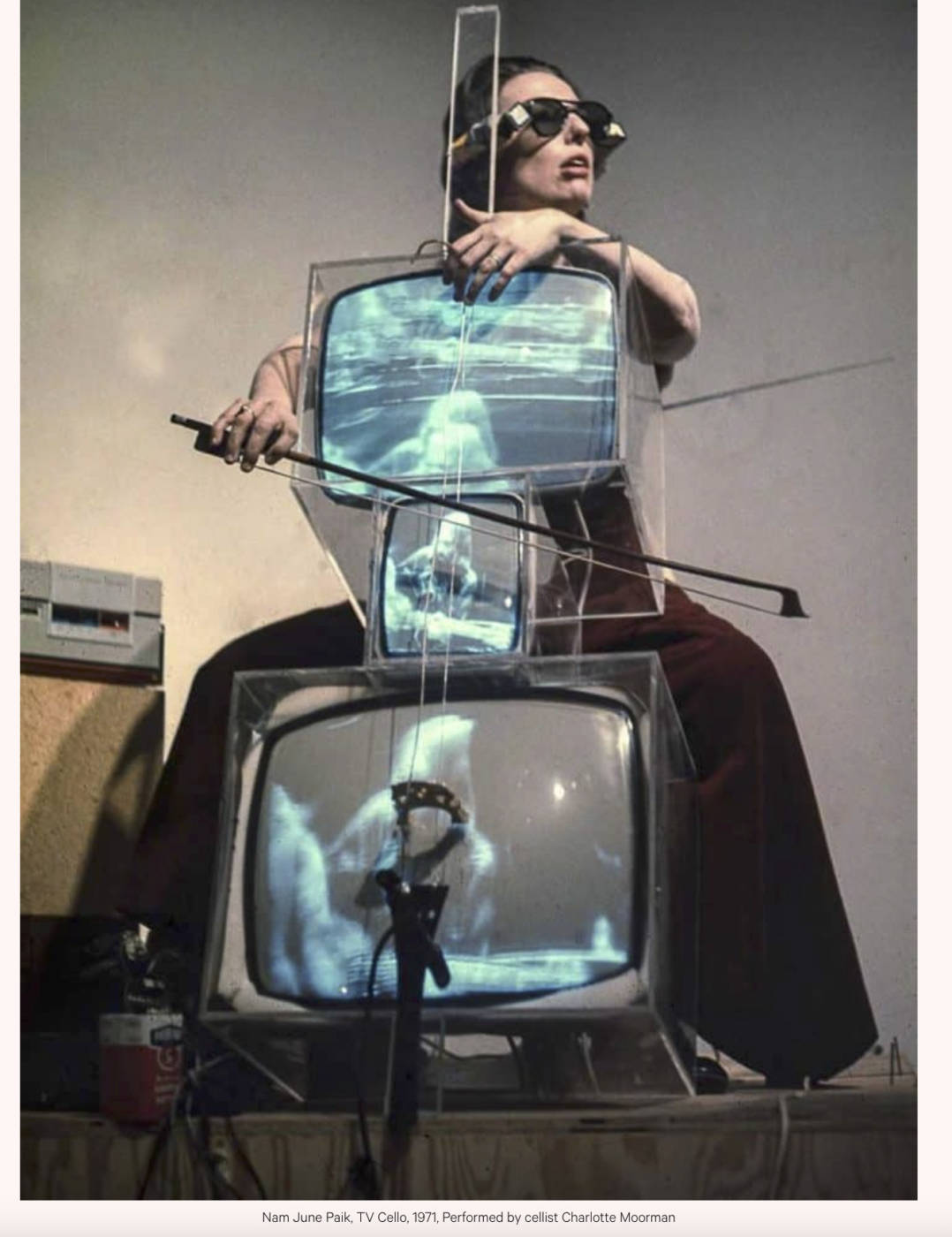
Nam June Paik was a Korean American artist, widely considered to be the founder of video art. From 1962 he was a member of the avant-garde art movement Fluxus, and was the first proponent of utilising television sets as the principal material component of his sculptural assemblies. He is credited with one of the first video works in the mid-Sixties after the introduction of hand held video recording equipment for the general population, making increasingly elaborate stacks of video monitors and television based sculptures from the 1970s onwards.
If conceptually informed artworks are ones in which an idea determines the work. You can think of some of the works below as a response to a simple, one sentence instruction. (From https://magazine.artland.com/history-of-video-art-part-i/)
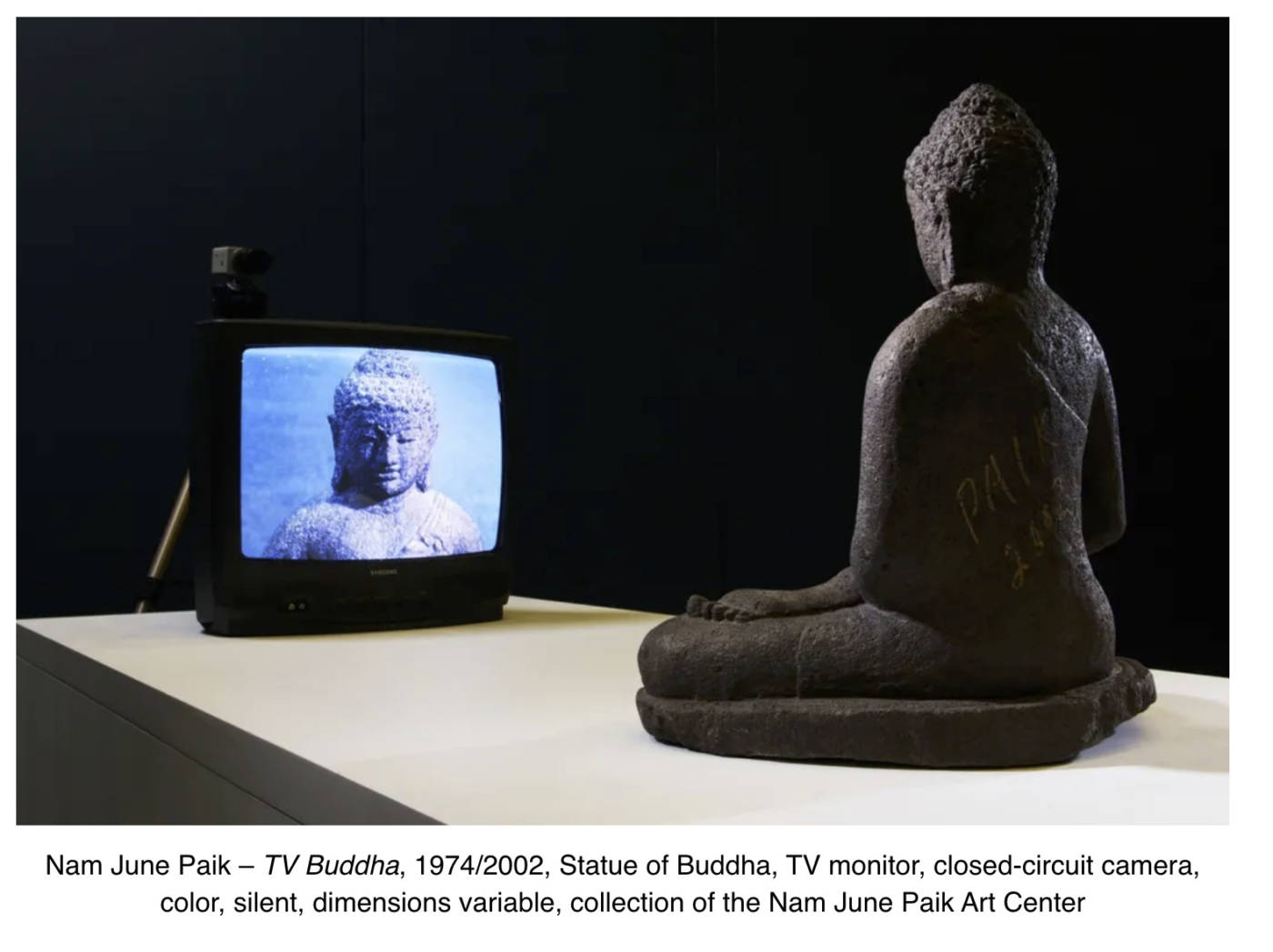
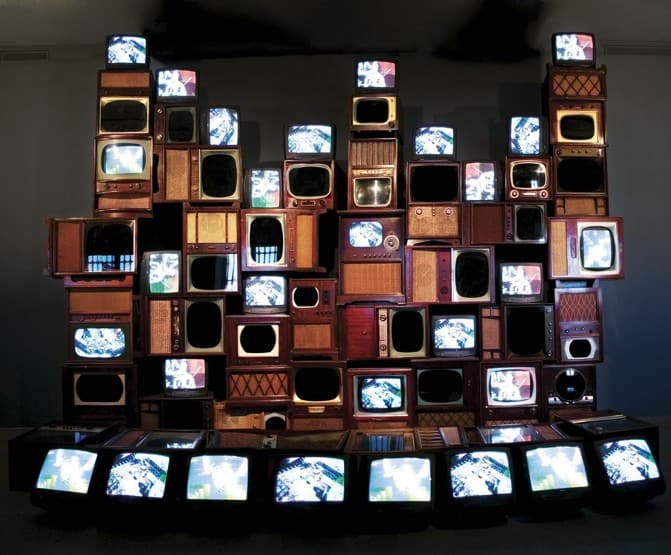
Born in 1941 in Fort Wayne, Indiana, Bruce Nauman has been recognized since the early 1970s as one of the most innovative and provocative of America’s contemporary artists. Nauman finds inspiration in the activities, speech, and materials of everyday life. Confronted with the question “What to do?” in his studio soon after leaving school, Nauman had the simple but profound realization that “If I was an artist and I was in the studio, then whatever I was doing in the studio must be art. At this point art became more of an activity and less of a product.” (From https://art21.org/watch/art-in-the-twenty-first-century/s1/identity/)
Abramović was raised in Yugoslavia by parents who fought as Partisans in World War II and were later employed in the communist government of Josip Broz Tito. In 1965 she enrolled at the Academy of Fine Arts in Belgrade to study painting. Eventually, however, she became interested in the possibilities of performance art, specifically the ability to use her body as a site of artistic and spiritual exploration. After completing postgraduate studies at the Academy of Fine Arts in Zagreb, Croatia, in 1972, Abramović conceived a series of visceral performance pieces that engaged her body as both subject and medium. In Rhythm 10 (1973), for instance, she methodically stabbed the spaces between her fingers with a knife, at times drawing blood. In Rhythm 0 (1974) she stood immobile in a room for six hours along with 72 objects, ranging from a rose to a loaded gun, that the audience was invited to use on her however they wished. These pieces provoked controversy not only for their perilousness but also for Abramović’s occasional nudity, which would become a regular element of her work thereafter.
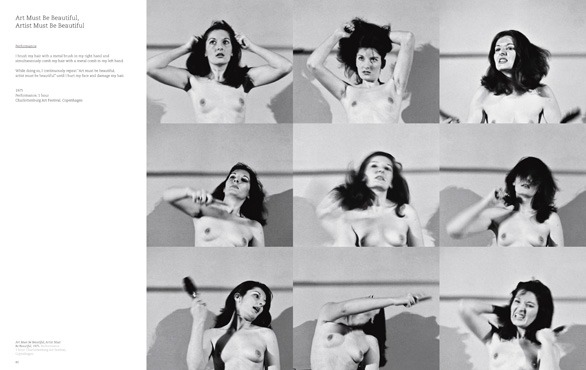
Art Must Be Beautiful, Artist Must Be Beautiful is one example of how, in the early years of performance art, female artists used their own bodies to challenge the institution of art and the notion of beauty. Marina has said in an interview that during the 1970s, “if the woman artist would apply make-up or put [on] nail polish, she would not have been considered serious enough.”
In their performance piece Breathing In/Breathing Out Marina Abramovic and Ulay blocked their noses with cigarette filters and clamped their mouths tightly together, breathing in and out each other’s air. After seventeen minutes they both fell to the floor unconscious. The viewers could sense the tension through the sound of their breathing, which was augmented through microphones attached to their chests. Is it a beautiful romantic gesture or a comment on how relationships absorb and destroy an individual?
“Something tender and violent at the same time emerges from the performance: the couple are decided to stick together despite the effort, the danger, the damage; but as is the case with human relations of this kind of intensity, they end up with violence, pain, and a part of each other ‘dead’. It is the idea of interdependency portrayed to its extreme.” Interartive
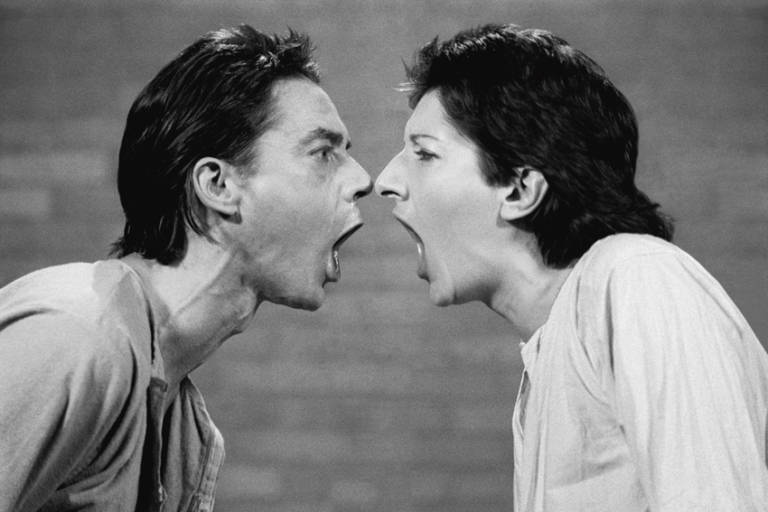
AAA-AAA (performance RTB, Liege), 1977
AAA-AAA centres on the relationship between two lovers. They started from an equal position to end up outdoing each other.
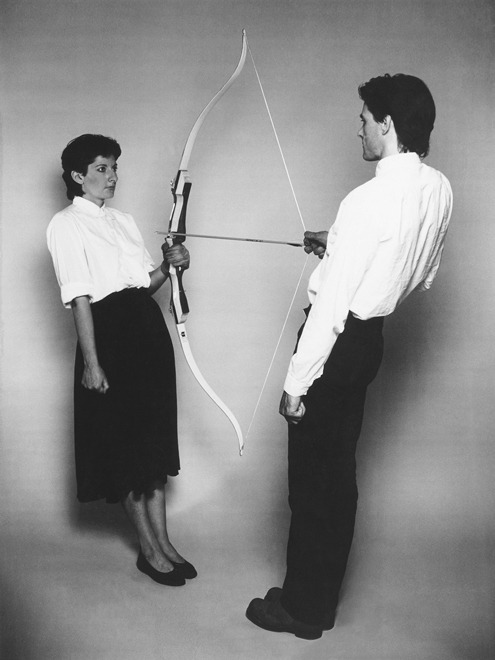
Abramovic, Marina; Ulay, «Rest Energy», 1980
Standing across from one another in slated position. Looking each other in the eye. I hold a bow and Ulay holds the string with the arrow pointing directly to my heart. Microphones attached to both hearts recording the increasing number of heart beats.
Candice Breitz
‘Legend (A Portrait of Bob Marley),’ 2005
Breitz’s experiments in the field of portraiture can cumulatively be described as an ongoing anthropology of the fan.
In each case, Breitz first sets out to identify ardent fans of the musical icon to be portrayed, by placing ads in newspapers, magazines and fanzines, as well as on the Internet. Those who respond to this initial call (typically numbering in their hundreds) are then put through a rigorous set of procedures designed to exclude less than authentic fans of the celebrity in question, in order to arrive at the final group of participants.
The individuals who appear in these works have thus stepped forward to identify themselves as fans, and have been included purely on this basis: all other factors – their appearance; their ability to sing, act or dance; their gender and age – are treated as irrelevant for the purpose of selection. Each of the selected fans is offered the opportunity to re-perform a complete album, from the first song to the last, in a professional recording studio. The portraits evoke their mainstream entertainment counterparts (such as American Idol or Pop Idol), but also take significant distance from their reality television cousins: Breitz promises her subjects neither fame nor fortune. What she offers them is an opportunity to record the songs that have come to soundtrack their lives in whatever way they choose. The non-hierarchical grids that she uses to organize the final presentation of the fans in each portrait, allow Breitz to deliberately sidestep the question of who has fared better or worse under the conditions that she has created for these quasi-anthropological visual essays on the culture of the fan. Whether the fans who pay tribute to their icons in her portraits are victims of a coercive culture industry or users of a culture that they creatively absorb and translate according to their needs, is left to the viewer to decide. If the dignity of the portrayed fans remains surprisingly intact, it is because rather than prompting us to laugh at the fans that she lines up, Breitz forces us to reflect on the extent to which pop music has infiltrated our own biographies.
Titling the series of works as she does, Breitz asks that we locate these multi-channel installations within the genre of portraiture, and prompts the question of how they in fact relate to this most humanist of genres. (From the artist’s video channel)
Ryan Trecartin (b.1981) is a contemporary American artist who works largely in video. While his work often incorporates ideas and images related to social media and technology, he claims that he is interested primarily in relationships and the ways in which the Internet has changed how people relate to the world and one another.[1] While Trecartin often posts his movies online and draws recurring themes and motifs from Internet culture, he also builds sculptural environments and installations in museums for showing his work.[2] In What’s the Love Making Babies For, Trecartin employs digital manipulations, extreme editing, and chaotic dialogue in a way that is characteristic of his artistic style, creating a world that is “hyper-saturated with media.” [3] More relevant to the concerns of this program, he also engages with ideas of authority, expertise, and the dissemination of information, as his characters forward their often warped and sometimes indecipherable ideas surrounding “reproduction, sexuality, and contemporary moralities” by engaging with traditional formats such as the TV commercial.[4] However, Trecartin roots his movie in the digitized Internet landscape, thus evoking questions surrounding how modes of communication and information transmission transform and morph in the digital age. (From [1] Calvin Tomkins, “Experimental People,” The New Yorker, March 14, 2014, http://www.newyorker.com/magazine/201…. [2] Ibid. [3] “What’s the Love Making Babies For,” Electronic Arts Intermix, accessed December 14, 2015, http://eai.org/title.htm?id=12291.he
1 km / 1000 m / 127 stairs
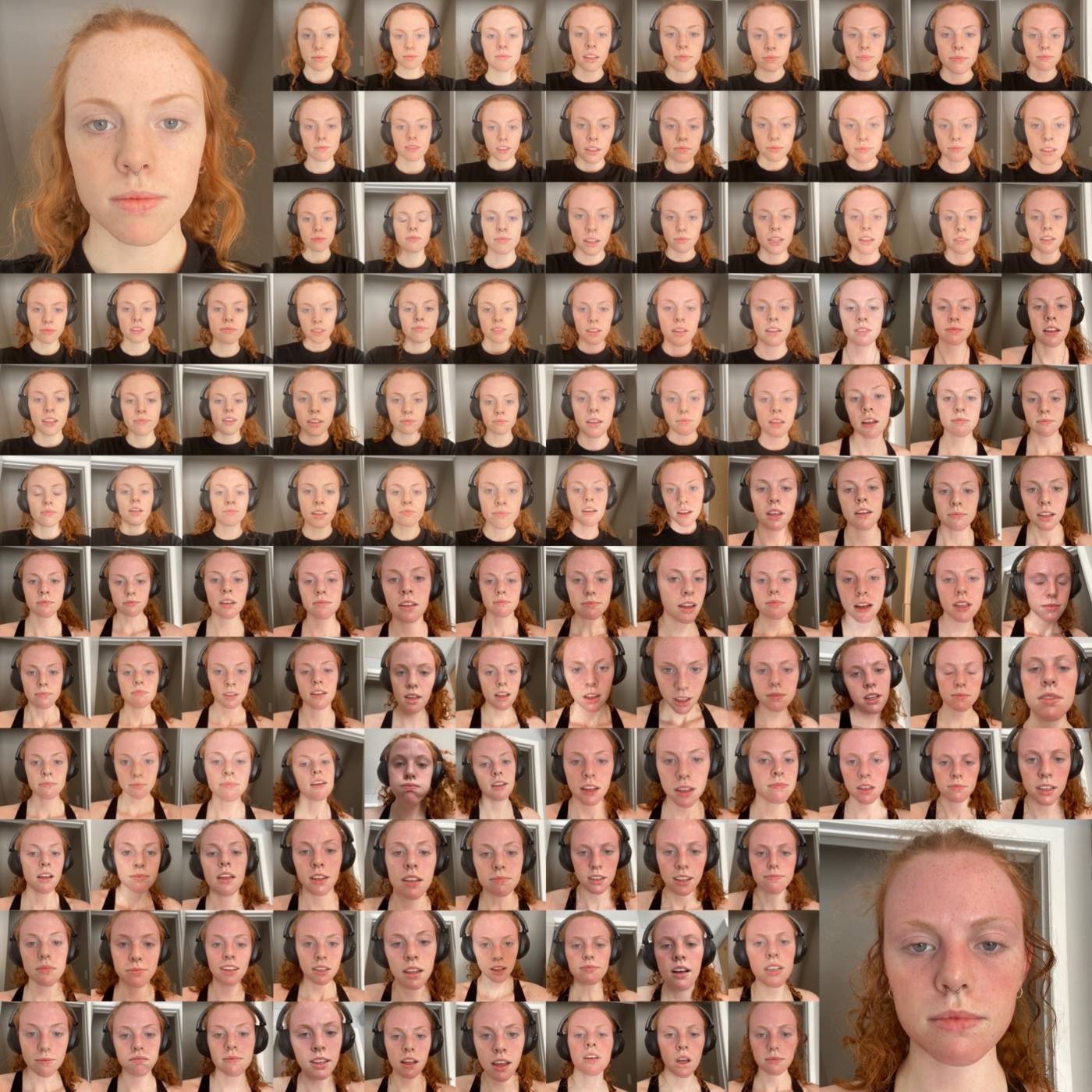
1 km / 1000 m / 127 stairs (IMAGE #1)
127 different pictures depicting the process of a killometre as it shows through on my increasingly flushed face. 127 photos were taken (Including a before and after) The other 125 images each represent a set stairs I comepleted. One set is equal to once down and once up. A photo was taken each time I reached the top of the stairs.
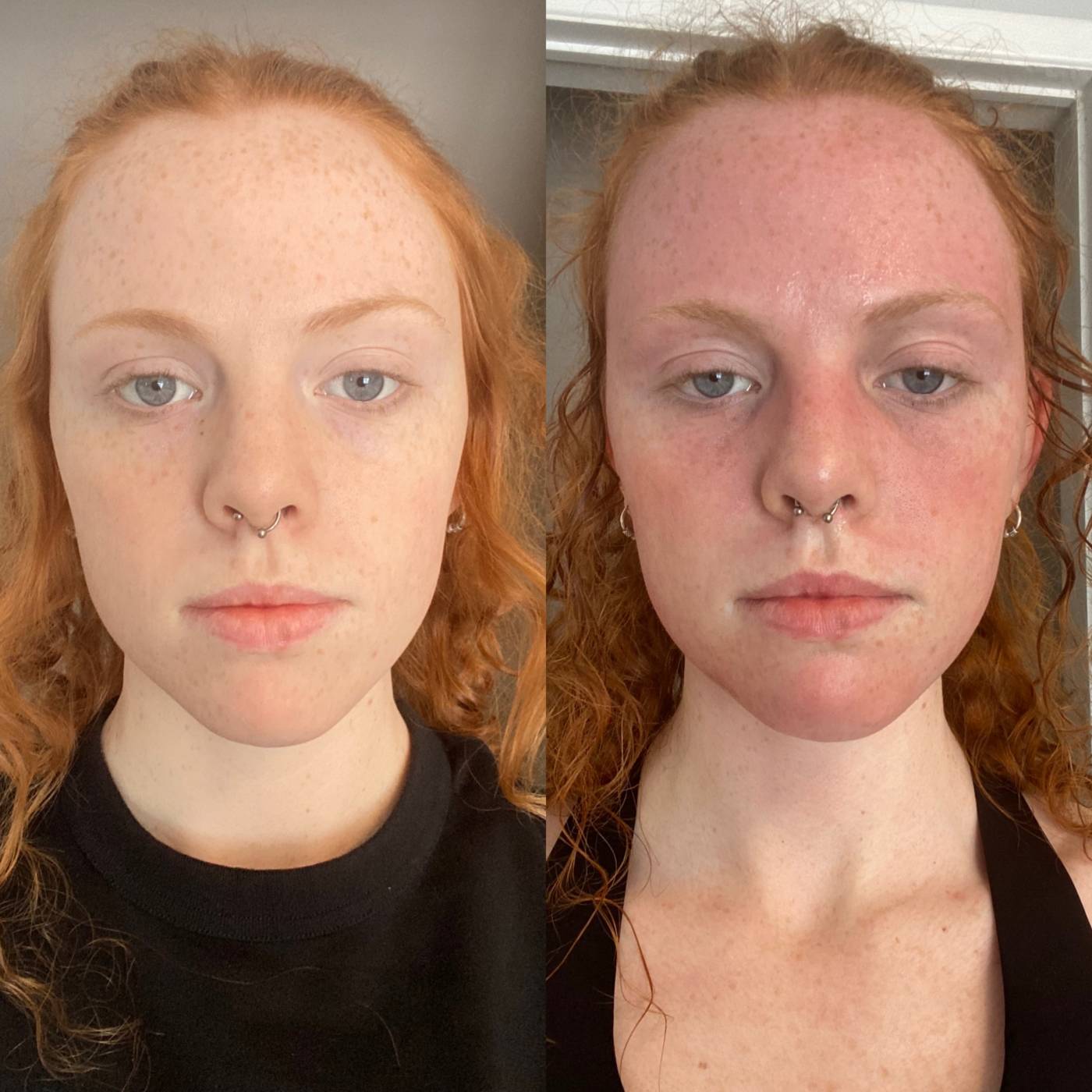
This video tooks us the longest to make, but ultimately I feel it paid off. There was a lot of learning involved durring the shoot, which took a lot of time, and we were tired. That being said there is something enagaing about this tirednesss and I am glad it happened this way.
Something that stands out to me about this video is our braids and glasses. We talked about how these choices gave us a youthful/child like presence, while obviously not being children. This coupeld with the bubblegum makes a somewhat uncomfortable illusion to childhood and the school girl trope, which I find engaging.
Something enticing about this video is the the closeness. We talked in class about covid and the impliactions salvia, germs, and space and I think this video really showcases this.

In the comfort of embers – Amartey Golding
Visting the Toronto art gallaries was a very inspiring and interesting experience overall. That being said, there was one exhibit that stuck with me the most, this was in the comfort of embers. The room facilitating the art work was a completely immersive experience. Its blood red walls, low lighting, and eeire sounds created a chilling ambience. Even though this was primarily a video driven exhbit, I was actually most intrigued by one of the costumes worn in the video.
The costume pictured on the right captured my attention immediately. I had never seen anything like it. The texture, pattern, and spectacle of a peice made out of hair was something to behold. And even though I hadn’t watched the videos, I was able to convey a similar message absent of context – I was argubaly more imapcted by this costume independently.
This audio peice features a compilation of noises taken from my shared student house bathroom. Inspired by our faulty cabinet hinges ( they produce an echoing click whenever you open them) I tried to complile a varity of noises to emmualte the sounds I wake up to most mornings -in this way it becomes a portrait of my experience living in this house/time. Every morning I hear my roomates morning routines and these noises parrel the rythmn of music. The rythmn is is drawn from the sound of my hair brushing. The tempo accompaning is taken from the clicking cabinets. The fast clicking is a small clip taken from the uncapping of my hair cream bottle.

For my artist buttons I choose to create a collection of smiling stock images. Originally I had wanted to craft buttons that played into the absurdity of stock images and what that meant socially; However, as I was collecting images I realized how much the white man domaintes the stock images (particularly a white man in a blue shirt). The more I collected these the more absurd and strange the collection became. These buttons challenge the idea of representation in media, but also what it means to objectify something or someone. This objectification does not ussually occur with people that look like the people in my buttons, which is an interesting shift. Addtionally the fact that they are buttons allows for intresting converstaitons depending on who is wearing it. What does is mean for a women of colour to wear a button of a white man?
You must be logged in to post a comment.